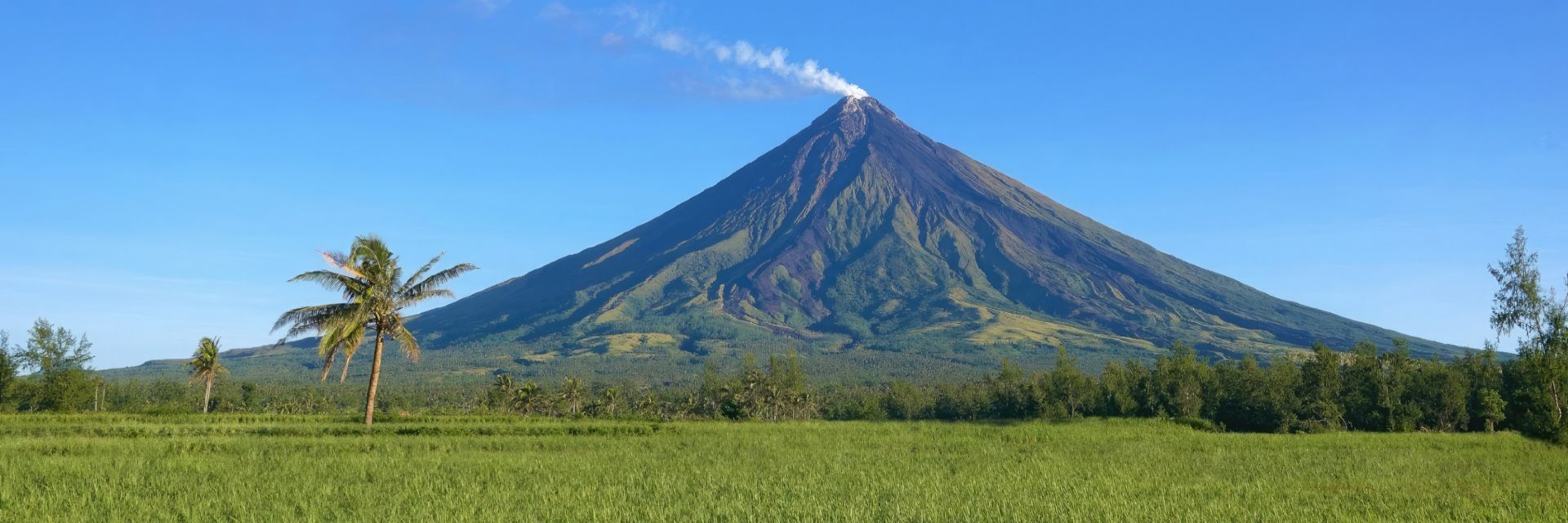[Editor's Note: This article was originally published in June 2019.]
Composite volcanoes – also known as stratovolcanoes – are among the most common volcanoes. But what are they, how do they form, and what sets this type of volcano apart as the most dangerous on Earth? Many thousands of people have died as a result of composite volcano eruptions in the past, and millions live in potential danger today. Let’s learn about volcanoes of this type and take a look at some of history’s most infamous examples: Mount St. Helens, Krakatoa, and Mount Vesuvius.
◊
Imagine a volcano. What do you see?
It’s likely you’re thinking of a cone-shaped mountain, towering over lower ground and threatening imminent danger. If that’s your mental image of a volcano, you’re picturing a composite volcano.
There are three major types of volcano: the shield volcano, such as Mauna Loa in Hawai’i; the cinder cone volcano, such as Italy’s Mt. Etna; and the composite volcano, which distinguishes itself from the others not just geologically but in one unforgettable way: Composite volcanoes make history.
What is a Composite Volcano?
Composite volcanoes, also known as stratovolcanoes, represent more than 60 percent of the volcanoes on Earth. Many of our planet’s most well-known volcanoes fall into the stratovolcano category – Mount St. Helens in Washington State, Mt. Fuji in Japan, and even Mt. Vesuvius in Italy, which infamously terrorized and destroyed the ancient city of Pompeii, burying it in volcanic ash.
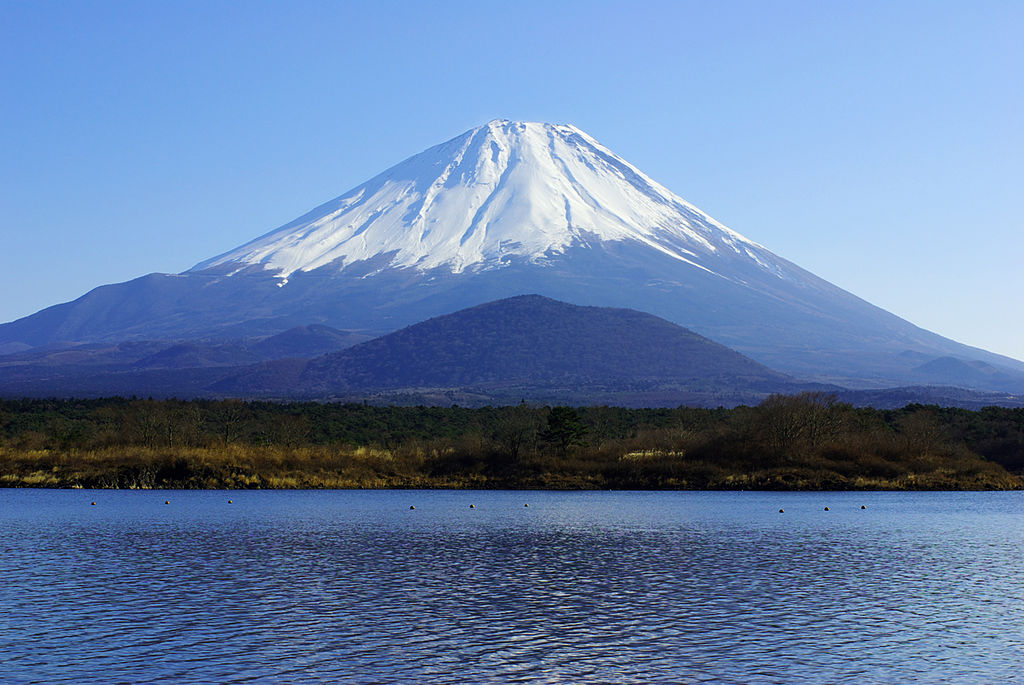
Mount Fuji (Image courtesy of Wikimedia)
The creation of a composite volcano does not happen overnight. Instead, it’s a slow process that takes hundreds of thousands of years. Throughout its formation, a composite volcano will erupt multiple times – fluctuating between quiescent and eruptive stages. A volcano is said to be quiescent when its mouth is obstructed; during periods when its mouth is continuously open, it is termed eruptive. Each eruption builds up the volcano, layer by layer. And, just as the term “composite” suggests, this type of volcano is comprised of various parts or elements, with layers combining different geological materials – lava, ash, rock, and pyroclastic flows.
Pyroclastic flow is a dense mass of hot ash, lava fragments, and gases that are produced from a volcanic explosion. The mixture flows downslope at a great speed, and leaves destruction wherever it touches.
While composite volcanoes erupt less frequently than the other types of volcanoes, they sure make up for it, packing quite a punch with each blast. The lava from a composite volcano is less fluid, and the thick mixture of minerals it contains are highly explosive. The results are very dangerous, and often deadly.
The Life Cycle of a Composite Volcano
Are you an implosive or explosive type of person? If you’re an implosive type of person, you’re most likely to keep your feelings bottled up. Bad day at work? Car break down? Get a speeding ticket? You’re likely to keep quiet, and keep on moving. But that one day, when you get cut in line … BOOM! You explode in one large burst, big enough to take care of all the other stress you’ve been burying.
That’s just like a composite volcano.
How big can a composite volcano get? While sizes vary, the base can grow to be as wide as five miles across, and the peak can reach as high as 8,000 feet.
A composite volcano will stay dormant for hundreds of years – looking peaceful and quiet to the casual observer. That is, until enough pressure builds up over centuries, and suddenly the volcano explodes, leaving devastation in its wake.
How do Composite Volcanoes Erupt?
When a composite volcano is ready to erupt, magma rises up through a conduit system from a reservoir deep beneath the Earth’s crust. The magma can erupt out of several vents (known as fumaroles) or from a large central crater at the summit of the volcano. Most commonly, it’s the latter. Horrifyingly enough, during an eruption, the pyroclastic flow can be ejected from a volcano at speeds as fast as 100 miles per hour. The lava then flows over the surrounding area. This lava cools and continues the process of building the volcano up.
What Happens When Large Composite Volcanoes Explode?
When a composite volcano erupts, the ash can shoot up as high as 20,000 feet, and can blanket the surrounding land for more than 300 miles. But an eruption doesn’t just affect land surrounding the volcano; it may also leave behind a collapsed region in the volcano, forming a steep-walled depression called a caldera. It’s here where a new volcano will form and start the building process again.
One famous example of a caldera is seen on Mount St. Helens in Washington State. Prior to its eruption in 1980, the deadly volcano had a pointed top – much like an unassuming mountain peak, but terror churned inside. Once St. Helens erupted, the gentle peak left a bowl-shaped depression – a caldera.
Hot lava isn’t the only threat that composite volcanoes may pose – the ash that rises from them can have disastrous effects. Ash can remain suspended in the atmosphere and significantly impact the world’s climate. Effects have even included severe winters that span many years, as was the case after Mount Pinatubo in Indonesia erupted in 1991.
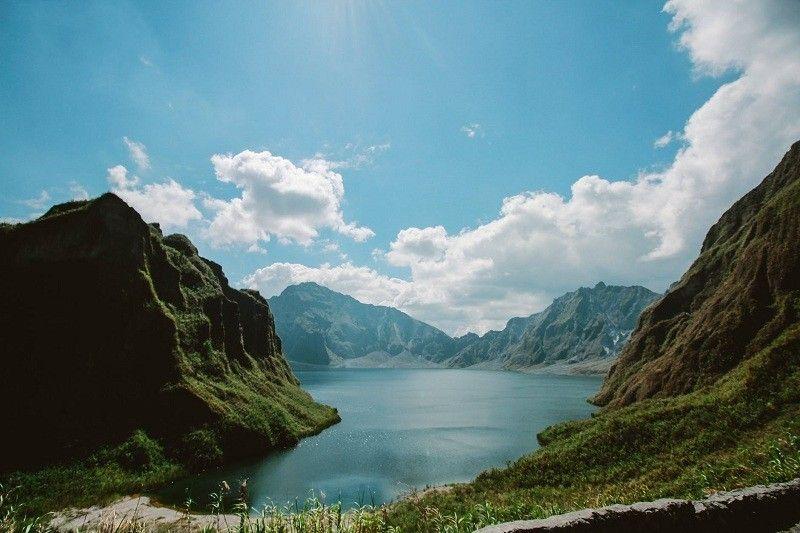
Mt. Pinatubo (Image courtesy of Belle Co, via Pexels)
But the threat doesn’t last forever. The cycle of explosions continues until the volcano becomes dormant. Once it enters this state, erosion wears it down to near nothingness. After what could be thousands of years, the cone is stripped away and the volcanic plug becomes exposed. The volcano continues to erode until all that remains is the “volcanic neck” and a small mesa. For a viewer, it’s almost impossible to believe that such disastrous effects could have come from the resulting stump.
.jpg)
A volcanic neck: Devil's Tower, Wyoming.
(Image courtesy of jtstewart, via Wikimedia)
Famous Composite Volcanoes Throughout History
Historically, as we discussed, the volcanoes that strike fear into our hearts and wreak the greatest havoc are composite volcanoes – and I’d bet you know some of their names. They are located around the world from the Pacific’s Ring of Fire to European countries, from Africa to the Americas.
The Ring of Fire is an area where earthquakes and volcanic eruptions occur abundantly all around the Pacific Ocean. Most of the world’s eruptions occur in this region, which spans a 25,000 mile arc.
Let’s look back on a few of the most violent and most deadly composite volcano eruptions human beings have ever experienced.
1. Mount St. Helens

Mount St. Helens
(Image courtesy of Lyn Topinka, via Wikimedia)
At 8:32 a.m., on Sunday, May 18, 1980, the state of Washington was hit with a geological chain reaction that produced a terrifying natural disaster: the most destructive volcanic eruption in the history of the United States.
It all started when an earthquake shook the southwestern region of Washington. While the quake itself wasn’t particularly devastating or even unusual for the Pacific Northwest (it measured at a moderate 5.1 on the Richter scale), the aftereffects certainly were.
Stationed just six miles north of Mount St. Helens, U.S. Geological Survey (USGS) volcanologist David Johnston was studying the waking giant. On that fateful morning, he radioed his last haunting words: “This is it!”
The quake didn’t only shake the surrounding towns, it also powerfully impacted the majestic Mount St. Helens, which had never seemed particularly threatening to local residents. Suddenly, the north face of the mountain began to crumble and collapse, with rocky debris collecting and sliding into a massive avalanche. But that wasn’t all, and the worst was yet to come.
The avalanche released pressurized gases within the volcano, like a shaken soda can, and caused a massive lateral, stone-filled explosion that flattened almost 230 square miles of forest and surrounding land. Like an atomic blast, the volcano birthed a mushroom-shaped cloud of ash that shot thousands of feet into the heavens. Washington State was blanketed in gray dust.
After a nine-hour long eruption, the region was unrecognizable. It looked like the set for a post-apocalyptic film.
Tragically, 57 people died, hundreds of homes were destroyed, thousands of animals were killed, and habitats were wiped out.
I have a small glass jar containing a bit of ash from that disastrous day. Looking into the bottle, one would never imagine the death and devastation that it represents. And while it sits unassumingly on my shelf, the state of Washington is still recovering from the massive blow.
2. Krakatoa
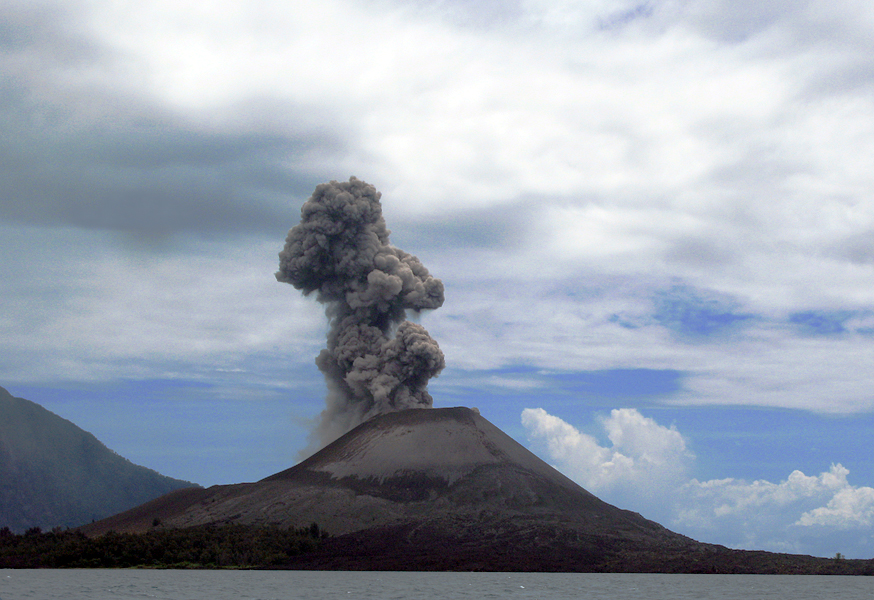
Krakatoa
(Image courtesy of flydime, via Wikimedia)
The eruption of Mt. St. Helens was impressive almost beyond belief, but travel further in time and distance, and you’ll find locations where the astonishing power of composite volcanoes created even greater chaos and destruction. The island of Krakatau in the Sunda Strait (part of what is now Indonesia) is one such place, and its volcano, Krakatoa, is a name that should send a shiver down your spine.
Preceding the horrific events of August 1883, Krakatoa generated speculation and wonder across the globe. Months prior to the explosion, a large cloud of ash was seen floating above Krakatoa. The sky lit up with incandescent clouds, and loud booming noises were heard from within the mountain. Commercial ships and sightseeing boats gathered round to spectate the magnificence of it all, and nearby islands hosted festivals celebrating the amazing beauty of the sight.
But the imminent danger was unforeseen, and three months later the idolized monument became the source of historic tragedy.
On the afternoon of Sunday, August 26, Krakatoa blasted a cloud of gas and debris an estimated 15 miles skyward. And that, unfortunately, was only the opening shot. The initial blast is thought to have caused more pressure in the neck of the volcano’s cone, and four more explosions followed the next morning.
Krakatoa’s blast was so tremendous that it was heard as far as 2,800 miles away, in Perth, Australia. For comparison, the Krakatoa eruption was nearly ten times more explosive than that of Mt. St. Helens.
It’s thought that more than 36,000 people died in the catastrophe – some from thermal injury, others from the tsunamis that followed to swallow the volcanic giant. When all was said and done, 165 coastal villages were destroyed, the sky remained dark for three days, and the average global temperature dropped by 1.2 degrees for five years.
3. Mount Vesuvius
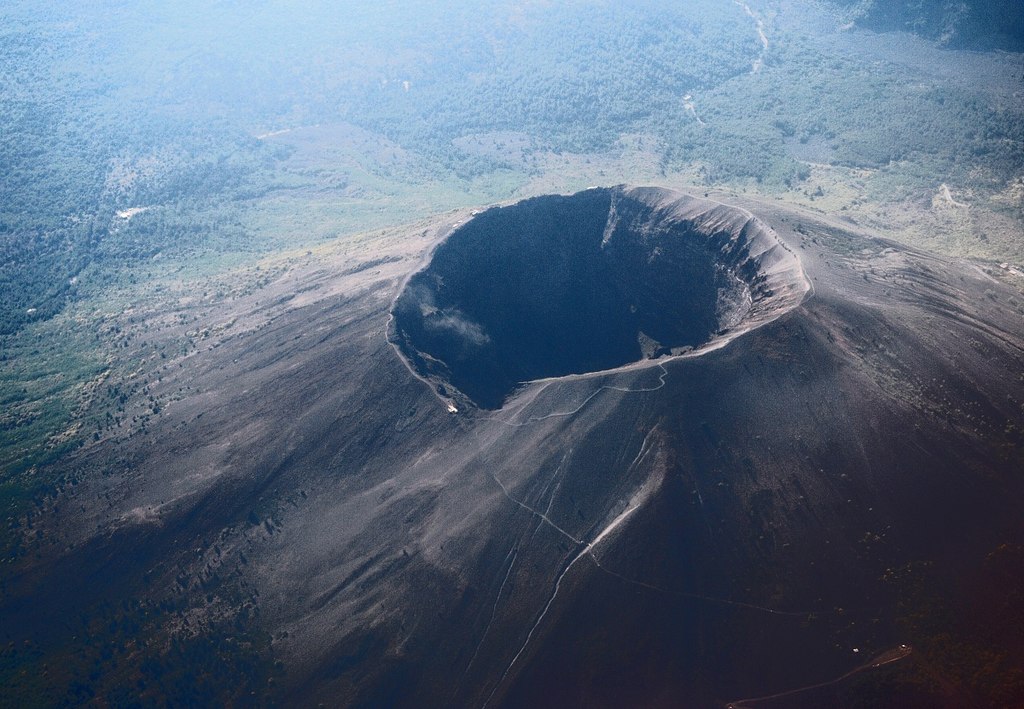
Mount Vesuvius
(Image courtesy of Pastorius, via Wikimedia)
Can you imagine living in a constant state of fear for your safety, constantly worried your home would be taken by hot ash and lava? If you were one of the Roman citizens living in the shadow of Mount Vesuvius in the year 79 C.E., these were probably pretty normal things to feel. But before that year, Mount Vesuvius did not seem to be of any threat – the volcano had been dormant.
It’s safe to say that most – if not all – have heard of Mount Vesuvius and the tragedy of Pompeii that took place in the year 79. Victims of the volcano lay buried, preserved, and untouched in volcanic ash for almost 1,700 years, cities were drowned, and the surrounding earth was pulverized.
The first city to be hit was Herculaneum. A wall of volcanic mud swallowed the town as citizens ran to the safety of nearby-Pompeii. But, unfortunately, there was no refuge to be found. Only a few hours later, volcanic gases and debris engulfed the city of Pompeii. Close to 30,000 people died that day in the horrifying violence of this volcano – most of them died instantaneously.
While Mount Vesuvius is most remembered for its destruction of Pompeii, there were other cities that were damaged, too: Oplontis, Stabiae, and Herculaneum were also hit hard by the historic tragedy.
The eruption of 79 C.E. was not the end of Mt. Vesuvius’s fury. In 1631, several earthquakes occurred over the span of six months, shaking the volcano and culminating in another major eruption on December 16 of that year. That explosion killed approximately 3,000 people. And Vesuvius still wasn’t satiated. Its activity became almost continuous and fluctuated between states of quiescence and eruption all the way into the 20th century until 1944, when it all seemed to stop.
Between 1631 and 1944, Mount Vesuvius alternated between quiescent and eruptive stages. During this time, eruptive stages lasted from 6 months to over 30 years, and quiescent stages from 17 months to 7½ years.
To this day, Mt. Vesuvius remains classified as active – and another explosion is thought to be overdue. Fortunately, with modern resources, experts are able to monitor seismic activity, gas emissions, and other indications of threat. With a watchful eye always focused on this beast of nature, the only other thing to do is hope – or pray, as I’d imagine many do. After all, there are currently more than two million people living in the vicinity of Vesuvius.
Ω
Title image: Mayon Volcano as of March 2020 by Marisa Mercado via Wikimedia Commons.
